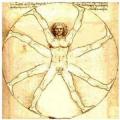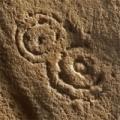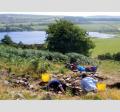- 17 JUILLET :
- GUATEMALA :  El Mirador - Great sweeps of Guatemalan rain forest, once the cradle of one of the world’s great civilizations, are being razed to clear land for cattle-ranching drug barons. “There’s traffickers, cattle ranchers, loggers, poachers and looters,” said Richard D. Hansen, an American archaeologist who is leading the excavation of the earliest and largest Mayan city-state, El Mirador, in the northern tip of the reserve. “All the bad guys are lined up to destroy the reserve. You can’t imagine the devastation that is happening.”
El Mirador - Great sweeps of Guatemalan rain forest, once the cradle of one of the world’s great civilizations, are being razed to clear land for cattle-ranching drug barons. “There’s traffickers, cattle ranchers, loggers, poachers and looters,” said Richard D. Hansen, an American archaeologist who is leading the excavation of the earliest and largest Mayan city-state, El Mirador, in the northern tip of the reserve. “All the bad guys are lined up to destroy the reserve. You can’t imagine the devastation that is happening.”
http://www.nytimes.com/2010/07/18/world/americas/18guatemala.html
- INDE : Ashapur - Project to reconstruct the Bhutnath temple. The Bhutnath temple which was built in the prevailing Bhumij style of architecture, was the most resplendent of the temples series in Ashapuri and was dedicated to Lord Vishnu. A glance at the ruins of the number of temples shows that the biggest of these temples were constructed on the banks of a vast lake. Though this lake was a natural one the Pratihar and Parmar rulers of 8th to 12th centuries constructed stone walls around it. A large ghat was also constructed here, the remains of which still exists.
http://www.newkerala.com/news2/fullnews-2090.html
-SUEDE / FINLANDE : Une équipe de plongeurs a remonté d'une épave en mer Baltique une bouteille de ce qu'elle pense être le plus vieux champagne encore buvable dans le monde, un flacon de Veuve Clicquot qui pourrait avoir été envoyé par Louis XVI... dans les années 1780. La découverte a été faite par 55 mètres de fond au large des îles Aaland, un archipel située à mi-chemin entre les côtes suédoises et finlandaises; plus de trente flacons au moins se trouvent encore dans les eaux de la Baltique. La bouteille est des années 1780. Or, Veuve Clicquot a commencé sa production en 1772, et ensuite les premières cuvées ont été élevées pendant dix ans, donc ça ne peut pas être avant 1782. Et cela ne peut pas être après 1788-89 avec la Révolution française qui a paralysé la production. Il s'agirait d'une livraison du roi Louis XVI au tsar russe Pierre le Grand. Le fabricant a trace d'un envoi qui n'est jamais arrivé à destination.
http://www.liberation.fr/monde/0101647548-un-champagne-du-xviiie-siecle-retrouve-par-des-plongeurs-en-mer-baltique
- 16 JUILLET :
- GRECE :  An extraordinarily toxic bacterium harbored by the "infernal" Styx River might have been the fabled poison rumored to have killed Alexander the Great (356 - 323 B.C.) more than 2,000 years ago, according to a scientific-meets-mythic detective study. According to the study, calicheamicin, a secondary metabolite of Micromonospora echinospora, is what gave the river its toxic reputation.The Styx was the portal to the underworld, according to myth. Here the gods swore sacred oaths.
An extraordinarily toxic bacterium harbored by the "infernal" Styx River might have been the fabled poison rumored to have killed Alexander the Great (356 - 323 B.C.) more than 2,000 years ago, according to a scientific-meets-mythic detective study. According to the study, calicheamicin, a secondary metabolite of Micromonospora echinospora, is what gave the river its toxic reputation.The Styx was the portal to the underworld, according to myth. Here the gods swore sacred oaths.
http://news.discovery.com/history/alexander-the-great-bacteria.html
- BULGARIE :  Perperikon - The excavations of one of Bulgaria’s most significant and best known archaeological sites, Perperikon, located in the south-eastern part of the country, will continue this summer even though the Ministry of Finance did not set aside funds to finance them. Finances will be secured from the revenue from tickets realized by the Perperikon site since 2009.
Perperikon - The excavations of one of Bulgaria’s most significant and best known archaeological sites, Perperikon, located in the south-eastern part of the country, will continue this summer even though the Ministry of Finance did not set aside funds to finance them. Finances will be secured from the revenue from tickets realized by the Perperikon site since 2009.
http://www.balkantravellers.com/index.php?option=com_content&task=view&id=2125&Itemid=29
- ROYAUME-UNI : Jersey - A team of archaeologists from London have found a number of stone tools used in Jersey from the Ice Age. The team has been focusing on La Cotte in St Brelade and Les Landes. Jersey is rich in the kind of sediment that preserves artefacts from that era.
http://www.jerseyinsight.com/news_1.aspx?id=0:11710&news=2:6780&tid=rss
- ETUDES : Duke's Pratt School of Engineering - While the evolution from the Neolithic solid stone wheel with a single hole for an axle to the sleek wheels of today's racing bikes can be seen as the result of human ingenuity, it also represents how animals, including humans, have come to move more efficiently and quicker over millions of years on Earth. Duke's Pratt School of Engineering, argues that just as the design of wheels became lighter with fewer spokes over time, and better at distributing the stresses of hitting the ground, animals have evolved as well to move better on Earth. In essence, over millions of years, animals such as humans developed the fewest "spokes," or legs, as the most efficient method for carrying an increasing body weight and height more easily.
Duke's Pratt School of Engineering - While the evolution from the Neolithic solid stone wheel with a single hole for an axle to the sleek wheels of today's racing bikes can be seen as the result of human ingenuity, it also represents how animals, including humans, have come to move more efficiently and quicker over millions of years on Earth. Duke's Pratt School of Engineering, argues that just as the design of wheels became lighter with fewer spokes over time, and better at distributing the stresses of hitting the ground, animals have evolved as well to move better on Earth. In essence, over millions of years, animals such as humans developed the fewest "spokes," or legs, as the most efficient method for carrying an increasing body weight and height more easily.
http://www.sciencedaily.com/releases/2010/06/100614074832.htm
- ROYAUME-UNI :  Londres - In the middle of London is a plot of earth, dug across with trenches and studded with old bricks. If theater has hallowed ground, this is it. It is the site of London's first theater, where William Shakespeare's plays were performed and where the Bard himself once trod the boards. Archaeologists who have been digging here since 2008 have uncovered a section of outer wall and floor surface from the building, completed in 1576 and known simply as The Theatre — whose timbers were later used to build The Globe theater. The bricks were the remains of a curved wall, indicating a polygonal building, a common style for Elizabethan theaters. Beside that was a patch of hard-pressed gravel, part of the area where the "groundlings" — theatergoers holding cheap standing-room-only tickets — crowded together to watch plays. Even older remains have been found, identified as part of a brewhouse from a medieval priory that once stood on the site. The archaeologists believe it was still functioning in Elizabethan times, serving beer to thirsty theatergoers. They have also dug up drinking vessels and pottery shards, including a piece of 16th-century jug decorated with the face of an Elizabethan gentleman, distinctive in his ruff and pointy beard.
Londres - In the middle of London is a plot of earth, dug across with trenches and studded with old bricks. If theater has hallowed ground, this is it. It is the site of London's first theater, where William Shakespeare's plays were performed and where the Bard himself once trod the boards. Archaeologists who have been digging here since 2008 have uncovered a section of outer wall and floor surface from the building, completed in 1576 and known simply as The Theatre — whose timbers were later used to build The Globe theater. The bricks were the remains of a curved wall, indicating a polygonal building, a common style for Elizabethan theaters. Beside that was a patch of hard-pressed gravel, part of the area where the "groundlings" — theatergoers holding cheap standing-room-only tickets — crowded together to watch plays. Even older remains have been found, identified as part of a brewhouse from a medieval priory that once stood on the site. The archaeologists believe it was still functioning in Elizabethan times, serving beer to thirsty theatergoers. They have also dug up drinking vessels and pottery shards, including a piece of 16th-century jug decorated with the face of an Elizabethan gentleman, distinctive in his ruff and pointy beard.
http://www.google.com/hostednews/ap/article/ALeqM5jHWNUNViVhjZczNg4LJ67hQ54LuQD9H060OG0
- ROYAUME-UNI :  Over - A remarkable piece of Neolithic rock art, unlike anything previously found in Eastern England, has been unearthed in the Cambridgeshire. It consists of a hand-sized slab of weathered sandstone with two pairs of concentric circles etched into the surface - a motif which, according to archaeologists, is typical of "Grooved Ware" art from the later Neolithic era; and it could date back to 2,500 BC. The remains of several settlement clusters from the late Neolithic period have already been found.
Over - A remarkable piece of Neolithic rock art, unlike anything previously found in Eastern England, has been unearthed in the Cambridgeshire. It consists of a hand-sized slab of weathered sandstone with two pairs of concentric circles etched into the surface - a motif which, according to archaeologists, is typical of "Grooved Ware" art from the later Neolithic era; and it could date back to 2,500 BC. The remains of several settlement clusters from the late Neolithic period have already been found.
http://www.physorg.com/news198495505.html
- 15 JUILLET :
- ROYAUME-UNI :  Bute - The Discover Bute Landscape Partnership Scheme (DBLPS) has been busy over the past two weeks trying to solve one of the many archeological mysteries of the island – the lost church of Quien. The site is an unusual rectangular structure within an enclosure. The tumbled stone walls looked very similar to known early Christian chapel sites from Bute and other places in Argyll. However, the usual sources of additional evidence which often point to an old church site, such as a place name beginning with 'Kil' (Gaelic for church), along with documentary and map evidence, or even locally-remembered stories don't appear to exist for Quien.The other– equally exciting – possibility was that the site was a medieval building, possibly an early farm.
Bute - The Discover Bute Landscape Partnership Scheme (DBLPS) has been busy over the past two weeks trying to solve one of the many archeological mysteries of the island – the lost church of Quien. The site is an unusual rectangular structure within an enclosure. The tumbled stone walls looked very similar to known early Christian chapel sites from Bute and other places in Argyll. However, the usual sources of additional evidence which often point to an old church site, such as a place name beginning with 'Kil' (Gaelic for church), along with documentary and map evidence, or even locally-remembered stories don't appear to exist for Quien.The other– equally exciting – possibility was that the site was a medieval building, possibly an early farm.
http://www.buteman.co.uk/news/Archaeologists-hunt-for-the-lost.6421159.jp
- U.S.A. :  Addison - Chimney Point. During the past 10 weeks, a team of archaeological field workers have made important discoveries. They’ve confirmed the location of a 1731 French fort long thought, but unproved until now, to be at the site, and they have uncovered extensive new evidence of the spot’s rich history. That history spans centuries, from the Revolutionary War to the French and Indian Wars to the Paleo-Indian era 9,000 years ago.
Addison - Chimney Point. During the past 10 weeks, a team of archaeological field workers have made important discoveries. They’ve confirmed the location of a 1731 French fort long thought, but unproved until now, to be at the site, and they have uncovered extensive new evidence of the spot’s rich history. That history spans centuries, from the Revolutionary War to the French and Indian Wars to the Paleo-Indian era 9,000 years ago.
http://www.burlingtonfreepress.com/article/20100715/NEWS02/100714018/Lake-Champlain-bridge-work-reveals-old-treasures